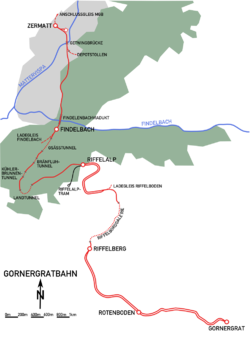Gornergratbahn
| Gornergrat Bahn | |||
|---|---|---|---|

A train approaching the summit station
|
|||
| Operation | |||
| Owner | BVZ Holding | ||
| Technical | |||
| Line length | 9.339 km (5.803 mi) | ||
| Number of tracks |
Single track |
||
| Track gauge | 1,000 mm (3 ft 3 3⁄8 in) | ||
| Electrification | 725 V, 50 Hz, 3-phase, 2 Overhead lines |
||
| Highest elevation | 3,089 m (10,135 ft) | ||
| Rack system | Abt | ||
|
|||
Single track
3.79 km (2.355 mi)
The Gornergrat railway (German: Gornergratbahn or Gornergrat-Bahn; GGB) is a mountain rack railway, located in the Swiss canton of Valais. It links the resort village of Zermatt, situated at 1,604 m (5,262 ft) above mean sea level, to the summit of the Gornergrat. The Gornergrat railway station is situated at an altitude of 3,089 m (10,135 ft), which makes the Gornergrat railway the second highest railway in Europe after the Jungfrau, and the highest open-air railway of the continent. The line opened in 1898, and was the first electric rack railway to be built in Switzerland.
The Gornergrat is a starting point for many hikes, as it lies surrounded by 29 peaks rising above 4,000 m (13,123 ft) in the Alps and several glaciers, including the Gorner Glacier (which is billed as the second longest glacier in the Alps). At the end of the line on Gornergrat, the Matterhorn is visible on a clear day. It is also a popular skiing area.
The Gornergrat railway company (Gornergrat Bahn AG) is a wholly owned subsidiary of BVZ Holdings AG, who are also the majority owners of the Matterhorn Gotthard Verkehrs AG, the company that operates the Matterhorn–Gotthard railway (MGB), with which the GGB connects in Zermatt.
Work on the railway started in 1896, five years after the Visp-Zermatt-Bahn had linked Zermatt to Visp and the Rhone Valley. The line opened on August 20, 1898, and was electrified from the start. Initially it only operated in summer, but year-round operation was extended to the lower section of the line in 1929, and to the summit in 1941.
...
Wikipedia

